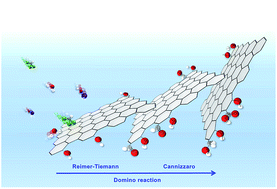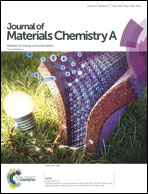Selective edge functionalization of graphene layers with oxygenated groups by means of Reimer–Tiemann and domino Reimer–Tiemann/Cannizzaro reactions†
Abstract
Graphene layers were selectively edge-functionalized with oxygenated functional groups, maintaining their bulk structure essentially unaltered. A reaction was performed between polyhydroxylated graphene layers (G–OH) and CHCl3/KOH/H2O. When the reaction with KOH/H2O was performed at 0 °C, by adding successive portions of CHCl3, the functionalization occurred with aldehydic functional groups. When G–OH reacted with CHCl3/KOH at room temperature, benzylic alcohol and carboxy groups were introduced. XPS, IR, Raman, and WAXD analyses indicated that the graphene layers were chemically modified with the abovementioned functional groups, without intercalated and/or absorbed molecules. It can thus be assumed that functionalization of G–OH with aldehydic groups occurred through the Reimer–Tiemann reaction and that the domino Reimer–Tiemann/Cannizzaro reaction led to aldehyde disproportionation. As further evidence and the first viable usage of the functionalization with aldehydic functional groups, chitosan was crosslinked with the graphene layers, obtaining flexible and electrically conductive carbon paper.



 Please wait while we load your content...
Please wait while we load your content...